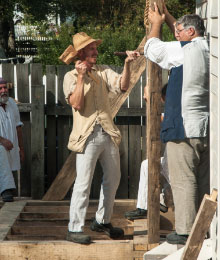
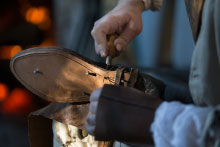
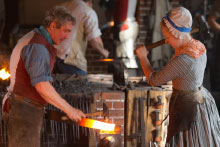
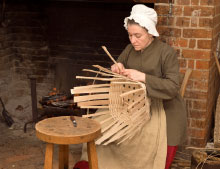
About Our Historic Trades
18th-Century Technology on Display
Preserving Ancient Skills
Colonial Williamsburg's Historic Trades program is the largest and most diverse 18th-century museum trades program in the world, and may be the most rigorous. We are unusual in that we have full-time craftspeople that not only demonstrate operations for visitors, but fully master and practice their trades.
Historic Trades staff work to learn about 18th-century objects, how they were made, and the world in which they were made. First and foremost, what we make aids Colonial Williamsburg's preservation and presentation of centuries-old technology. The things we produce are faithful reproductions or plausible reconstructions, based on extensive research of surviving objects, period descriptions and images, and the records of 18th-century craftsmen. They look, feel, sound, smell, and taste like 18th-century things. They are that way because we make them as they would have been made over 200 years ago. Most importantly, we preserve what we know by teaching new generations to practice these trades.
Who Uses Historic Trades Products?
The things we make are often part of large projects like the Market House and the Anderson Armoury reconstruction. Some items are used in Colonial Williamsburg's interpretive programs. We have produced things as diverse as a Revolutionary War-era cannon, chocolate for our cooking programs, and a fire engine we made in the 1980s. Other products are manufactured for sale at Colonial Williamsburg stores, from hardware or fine furniture to reproduced newspapers and pamphlets. Still other objects are custom-made for private individuals or for use in other museums around the country, such as the reproduction of George Washington's military tent and furniture—the first "Oval Office."
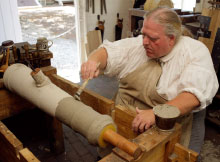
Learning by Doing
The production of historic objects presents both challenges and opportunities. We begin any project by examining and interpreting historical documents, and studying original objects for the clues embedded in them. But most importantly we experiment, hands-on. Only by actually doing a historic trade are we able to fully redevelop the knowledge, skills, materials, and tools of that trade.
The things we make are authentic. But it is the process of looking, noting details, comparing, analyzing, and being forced to make decisions (objective or subjective) about what is successful in design, fabrication, and decoration—and why—that is most valuable.
The staff in Historic Trades are historians, experimenters, risk-takers, and professional communicators. We like to tell intriguing and entertaining stories. Indeed, everything we make is a story. Whether it's a nail that takes thirty seconds or a building that takes three years, the process and the product give us stories to tell and, ultimately, speak for themselves.
